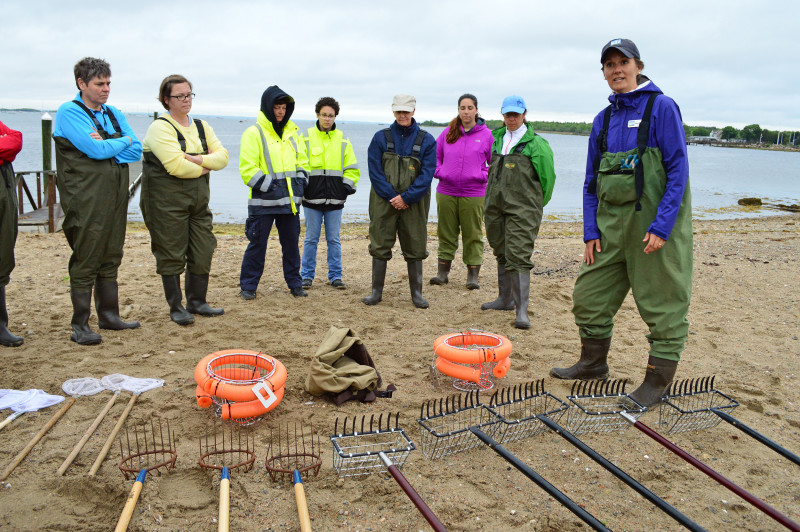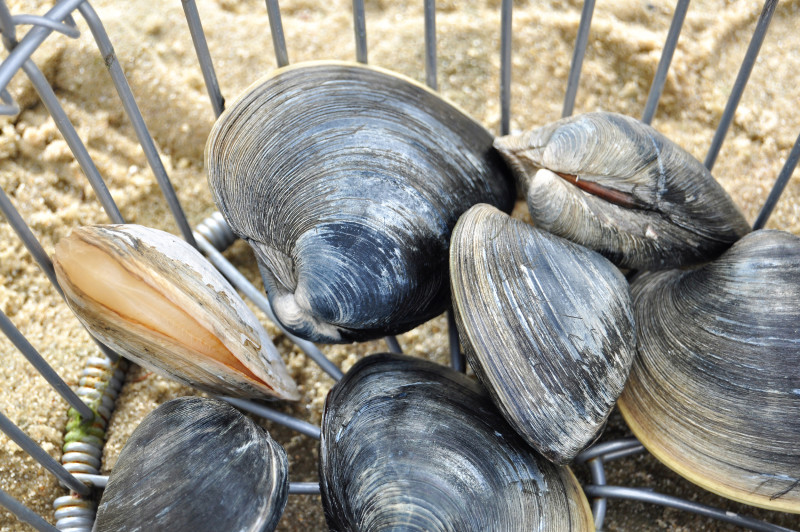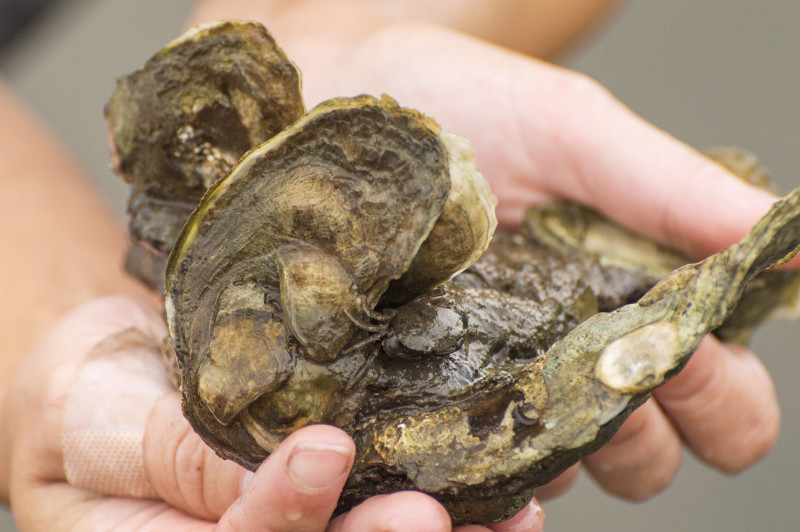How to dig for quahogs in Buzzards Bay
If you live near Buzzards Bay, then you’ve probably eaten a clam or two in your life. But have you ever tried to dig your own quahogs?
A quahog, in case you’re not sure, is another name for the hard clam, Mercenaria mercenaria. In fact, quahogs have several different names: for example, littlenecks and cherrystones are two different sizes of quahogs. These hard-shelled animals bury themselves a few inches below the mud, where they can live for more than 30 years.
Digging for quahogs is lots of fun, and easier than you might think. Plus, quahogging is a great way to get outside and enjoy the outdoors – and catch yourself a delicious dinner at the same time!
Here’s everything you need to know about quahogging in Buzzards Bay:
What do you need to go quahogging?
The most important thing you need before you dig for quahogs is a permit. In Massachusetts, each town issues local permits for recreational and commercial shellfishing. Even if you’re not a resident of a town, you can still buy a shellfishing permit to dig for clams there.
Here’s a link to each Buzzards Bay town’s shellfish license information:
- Westport: Shellfish Permit Information (Town Clerk) | Shellfish Rules and Regulations (Shellfish Wharfinger)
- Dartmouth: Shellfish Regulations (Office of the Select Board) | Shellfish Permit Types (Available at Town Hall)
- New Bedford: Quahogging Permit Information (City Clerk) | New Bedford Fish and Shellfish Consumption Rules and Recommendations (Environmental Protection Agency)
- Fairhaven: Shellfish Permit Application | Shellfish Rules and Regulations (Harbormaster & Shellfish Departments)
- Mattapoisett: Shellfish Permit Application – Rules & Regulations (Treasurer/Tax Collector) | Current Shellfish Restrictions Map and Info (Animal Control & Shellfish Department)
- Marion: Shellfish Permit Information | Shellfish Area Map, Rules and Regulations (Harbormaster)
- Wareham: Shellfish Permit Information | Shellfish Rules and Regulations (Harbormaster and Shellfish Division)
- Bourne: Shellfish Permit Application | Shellfish Rules and Regulations (Department of Natural Resources)
- Falmouth: Shellfish Permit (Tax Collector) | Open Shellfish Areas and Regulations (Shellfish Division)
- Martha’s Vineyard: Aquinnah Shellfish Regulations (Permits sold at Town Clerk Office) | Chilmark Shellfish Rules & Permit Information (Permits sold at Town Hall) | Tisbury Shellfish Regulations (Permits sold at Harbor Office) | West Tisbury Shellfish Regulations (Permits sold at Town Hall)
When you get your permit, make sure to find out where the open shellfish beds are located. These open shellfishing areas move from time to time to avoid overharvesting. Towns will also temporarily close shellfish beds after heavy rain storms if bacteria levels are too high.

In addition to a permit, you’ll need a few simple supplies to go quahogging: a peck basket, a clam gauge, and a rake. You may also want to don a pair of waders to stay warm and dry.
Here are a few other supplies you’ll need for clamming:
- Peck basket: These metal wire baskets are what you keep your quahogs in when you’re digging. More important, they hold the legal limit of clams that you’re allowed to keep each week. You can buy a peck basket at most local hardware or bait and tackle stores.
- Gauge: A quahog gauge is a flat piece of metal with a rectangular hole in the middle. This is how you measure your quahogs to make sure they are legal size: at least 1” thick at the hinge. If your quahog can’t fit through the hole, then it’s a keeper!
- Rakes: Rakes aren’t technically necessary – you can just use your hands and feet to dig in the mud! – but they’re a big help when you’re digging in water that’s deeper than your knees. The popular quahogging rake has a long wooden handle with short metal teeth and a small basket on the end.
- Waders: Like rakes, you don’t need waders to go quahogging. But waders will keep you dry if you don’t want to get wet, especially during cooler months.
The Coalition offers several free learn to quahog programs throughout the year as part of our Bay Adventures series. So if you want to give quahogging a try before you buy any equipment, then come along with us!
How are quahogs doing in Buzzards Bay?

More shellfish beds are open in Buzzards Bay today than there were 20-30 years ago. But bacterial contamination from polluted stormwater runoff still poses a threat in many areas.
Just like all the Bay’s living things, shellfish need clean water to survive. That’s why the Coalition works to conserve forests, salt marshes, and other important natural areas that help protect our water from pollution.
Quahogs help keep our water clean, too. Clams are filter feeders, which means they suck water into their bodies and filter out the “food” – including bits of algae. But if there’s bacteria in the water, quahogs will also absorb that pollution, which makes them bad for us to eat.
The good news is that more shellfish beds are open in Buzzards Bay today than there were 20-30 years ago. Back then, bacteria would often flow into the Bay from roads and sewage. Local communities have made lots of progress to minimize these pollution sources.
Now the Bay’s biggest challenge is nitrogen pollution. Nitrogen from homes, roads, farms, and septic systems fuels the growth of nasty algae blooms, which deplete the oxygen that shellfish need to live.
Thankfully, there’s a solution – us! We can all do our part to stop nitrogen from polluting Buzzards Bay. Try using less lawn fertilizer, and make sure to vote for clean water policies in your community.
What other types of shellfish can you catch in Buzzards Bay?

Oysters grow on top of each other and form dense reefs. Many species, such as crabs and small fish, depend on oyster reefs as a place to hide from predators.
Quahogs aren’t the only type of shellfish you can catch in Buzzards Bay. Here are a few other species of bivalves – clams, scallops, oysters, and other shellfish with two hinged shells – that are fun to harvest and delicious to eat.
- Bay scallops: These beautiful shellfish live among eelgrass beds in shallow waters. Unlike quahogs, bay scallops don’t bury themselves in the mud. Scallops can swim by clapping their shells together to propel themselves through the water.
- Oysters: Found in both shallow and deeper waters, oysters also live above the Bay’s bottom. But instead of swimming freely like scallops, oysters clump together to form reefs, sometimes on rocks and other hard surfaces.
- Softshell clams: Also known as steamers, softshell clams live close to the shore buried deep under the mud. If you walk along the beach during low tide and see lots of small holes in the mud, there are probably softshell clams hiding down there!
This post also appears on New England Boating.